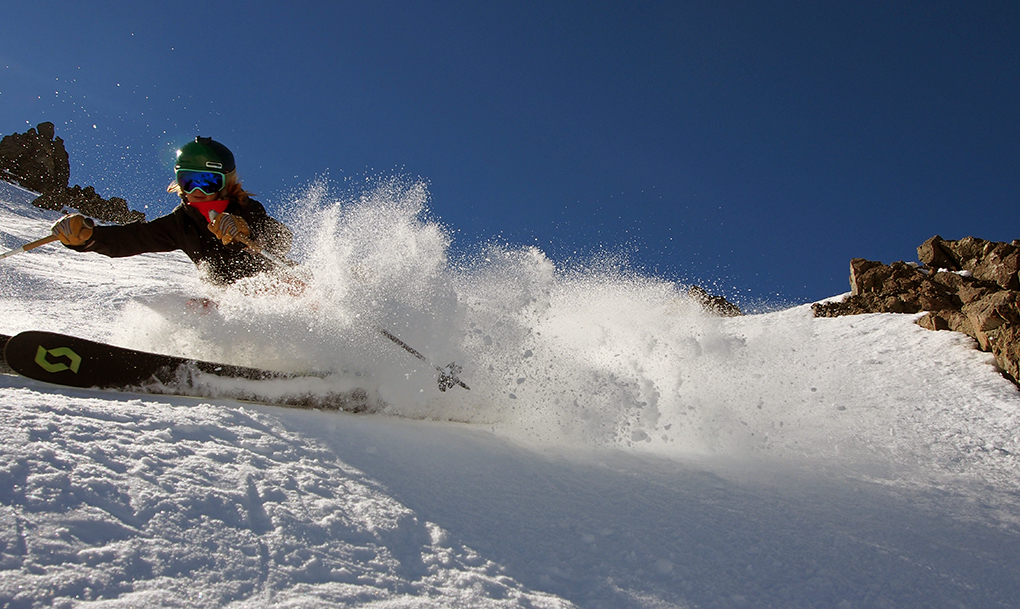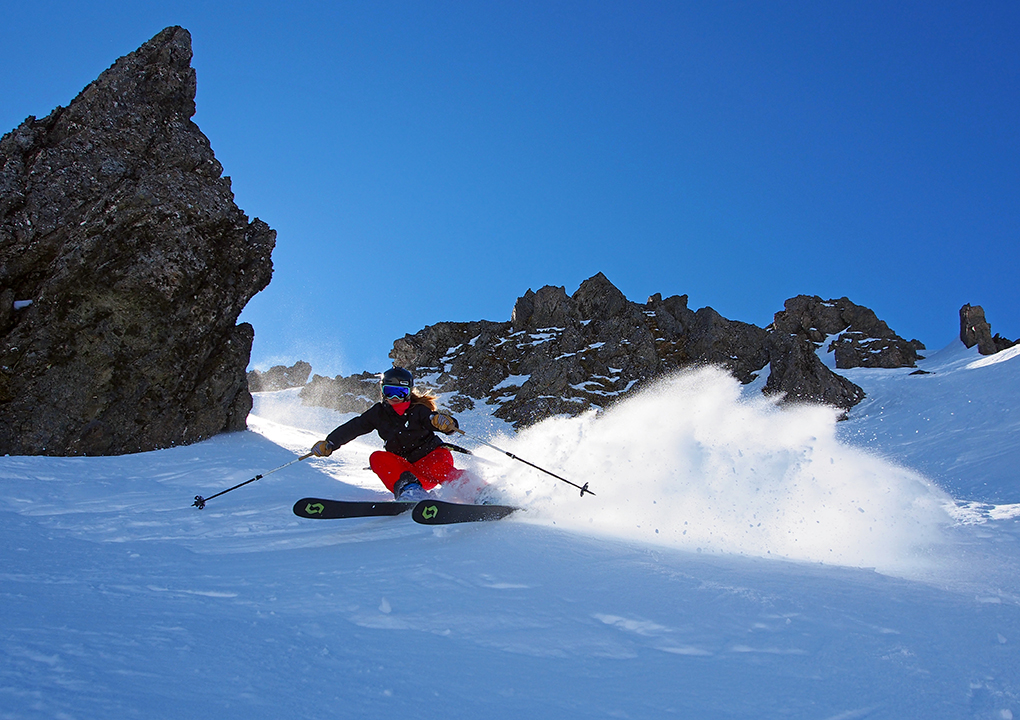
Ski: 2014-2015 Scott Vanisher, 173cm
Stated Dimensions (mm): 140-106-128
Mount Location: Recommended Line
Boots / Bindings: Lange RS 120 S.C. / Marker Griffin (DIN at 8)
Test Locations: Craigieburn Valley Ski Area; Broken River Ski Area
Days skied: 4
The widest women’s ski in Scott’s freeski lineup, the new Vanisher really caught my eye at SIA last February. The Vanisher has the same shape as the men’s hard-charging Punisher, but Scott describes it as a nimble, more soft snow-oriented ski with a soft-to-medium flex.
Like the Rossignol Savory 7, the Vanisher has tip and tail rocker with camber underfoot and is fairly light weight, so I predicted the Vanisher would work best in soft conditions and in consistent snow. Although I still need to get the Vanisher on groomers and in fresh powder, so far, my prediction has been largely correct.
Soft, Spring Conditions
For the last few weeks in New Zealand, we have encountered mostly high alpine spring conditions: firm and frozen hardpack in the morning, followed by softer slush mid-day, then refreezing in the afternoon shadows. On our first morning at Craigieburn, however, some cloud cover the night before prevented the snow from fully locking up, and allowed us to ski some softer snow right off the bat.
Throughout the day, I made a lot of fast laps on the Vanisher through slushy low bumps; shallow, fairly smooth corn; and some heavier spring chop. Craigieburn has a number of easily accessible runs from the top of the rope tow, all of which are different aspects and offer a wide range of snow types in a relatively small area. After my first run through some soft, very shallow chop, the word that came to mind to describe the Vanisher was, Fun.
Compared to all the skis I’ve been on in the past year, the Vanisher felt the easiest and most maneuverable. The ski was light on my feet and could be quickly thrown from side to side, with a smooth, buttery finish through the turn. While the Vanisher certainly preferred small-to-medium sized turns, in these slushy spring conditions, I could confidently make faster, larger radius turns down Siberia Basin.
As I mentioned before, the Vanisher’s flex is fairly soft. But while I felt like it didn’t take too much effort to overpower a ski like the Rossignol S3 W, the Vanisher still felt stable when driving the ski through consistent slush.

After spending some time in Siberia Basin, I made my way out to Hamilton Face, which had fewer tracks but more sun exposure. The snow in this basin was a bit deeper and more condensed, which created some issues for the Vanisher. In the thicker snow, it didn’t feel like the ski had quite enough power to work through chop. If I tried to drive the ski with more energy and speed, the shovels began to feel unsupportive and unpredictable. This isn’t too surprising, however, given the ski’s light weight and significant tip and tail rocker.
While the Vanisher is not a heavy crud-busting ski like the Punisher—and I wasn’t expecting it to be—I found that it could still handle chop at slower speeds and with smaller turns. Even though I would have preferred a damper ski with metal like the Blizzard Samba, the loose tail allowed me to navigate the chop with quick, easy direction changes.
Firmer Spring Conditions
In the late afternoon, we hiked up Hamilton Peak for a steep, longer run that continues into Hamilton Face. By this time, most of the softer spring snow was in the shade and had frozen into a chunky crust. These conditions were tricky for the Vanisher, and I had to ski somewhat cautiously and slowly through the crusty snow. Even at medium speeds, I was bucked around a bit and noticed the tips bouncing around more than I would have liked. Of course, these conditions are challenging on any ski, but the Vanisher was too light to provide a solid platform through the steeper, more demanding sections.
On the other side of the tow from Hamilton Face, Craigieburn has some really fun, steep chutes. Since they don’t get as much sun, the snow in there was a little smoother and buffed out, but still pretty firm. I loved taking laps through this area, and the Vanisher was quick and light enough that I had no issues with hop turns. While making more aggressive, strong turns, the tips began to feel a little chattery when tracking across the hill. Again, the Vanisher is light, and unsurprisingly, can’t charge quite as hard as a damper ski like the Samba.
Smoother, Firm Bumps
After skiing some great terrain at Craigieburn, we made our way over to Broken River, an adjacent club field that has its own fair share of exciting terrain. While at Broken River, we experienced some strong winds that kept the snow locked up in most sections throughout the day. At the same time, however, the wind also deposited snow between bumps throughout the Broken River Basin. The smooth, soft patches between smaller firm moguls skied beautifully, and the Vanisher was a great ski here.

With a little more speed, the Vanisher was quick and responsive, and even though I wasn’t laying into deep carves, I could get the ski up on edge easily. The playful, fun characteristics of the ski became much more apparent when skiing these predictable, and softer areas.
Rossignol Savory 7 vs. SCOTT Vanisher
Compared to other skis I have ridden, the Vanisher reminds me most of the Rossignol Savory 7. Like the Vanisher, the Savory 7 also measures 106mm underfoot, has a paulownia wood core, camber underfoot, and tip and tail rocker. Both skis feel very light, and both are playful and quick.
While I need to spend more time on the Vanisher in fresh snow and on groomers (and will update this review with that info as soon as possible), it seems like the Savory 7 and the Vanisher perform best in consistent conditions and in soft snow.
At this point, I can’t say for sure that I would choose one over the other since I need to evaluate the Vanisher’s carving ability and flotation. But I feel a slight difference in the skis’ stiffness. Both skis are light, but I noted in my review of the Savory 7, that the ski’s light weight didn’t translate into a soft ski. The Vanisher, on the other hand, feels a little softer than the Savory 7, and I didn’t feel comfortable pushing the ski quite as hard.
Who’s It For?
Ladies who are looking for a fun and easy soft-snow oriented ski will really enjoy the Vanisher. The light weight and playful design will make it a great option for intermediate to advanced skiers, but it is probably a little too soft as an every day ski for aggressive skiing. Given the ski’s shorter effective edge, and how nimble it feels underfoot, I would recommend sizing up for those who feel they are between sizes.
Bottom Line
Although the Vanisher is not a ski built for charging through chop and crud, or ripping big lines down steep faces, it is still a really fun ski in a range of conditions. So far, the Vanisher performs best in consistent and soft snow, and I predict that it will be an awesome option on powder days. For those looking for a ski that is light, easy, and fun, the Vanisher is definitely worth a look.
